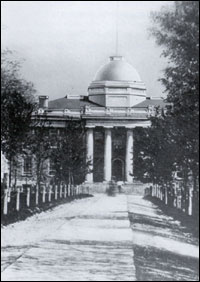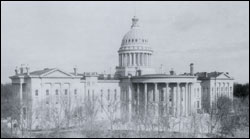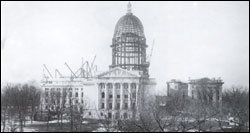|
| History |
 |
Facts About the Capitol's ArchitectGeorge Browne Post (1837 - 1913) started his career in 1858 after graduating from New York University with a degree in civil engineering. For two years, he studied architecture at the New York Studios of renowned architect Richard Morris Hunt.
In 1868, after a stint as an Army Officer in the Civil War, he opened his own architectural firm.
Post was part of the late 19th century architectural movement that pioneered the use of steel to make taller and stronger structures and several of his building's showed up on Manhattan's skyline. Although many do not stand today, they included the 20-story Pulitzer Building (1889-90); also known as the World Building and the 26-story St. Paul Building.
Post also participated in Chicago's Columbian Exposition in 1893, an important showcase for American beaux-arts style architecture. It was that exposition that fueled his desire to create "America's Grandest Monument" which he nearly constructed as a museum of history on the Hudson River in New York. Although that project never materialized, Post used a similar design, four proportional wings and a central dome, when designing the Wisconsin Capitol in 1906.
Post supervised much of the Capitol's construction as well as its interior design, but he died in November 1913, at the age of 76 before its completion. His sons - William S. and James O., who had joined their father in 1904 to form George B. Post & Sons, finished the project.
State Capitol Time Line1836
 On July 4, 1836, the Wisconsin Territory, previously a part of the Northwest, Indiana and Michigan territories, is organized at Mineral Point. The first Legislature meets at old Belmont (now Leslie, Lafayette County) on October 25, 1836, in a building rented from John Atchinson. It is a two-story, attic-framed building, forty-two feet by twenty-five feet, with a square battlement front. This building is preserved in its original state and is on the National Register of Historic Places. On July 4, 1836, the Wisconsin Territory, previously a part of the Northwest, Indiana and Michigan territories, is organized at Mineral Point. The first Legislature meets at old Belmont (now Leslie, Lafayette County) on October 25, 1836, in a building rented from John Atchinson. It is a two-story, attic-framed building, forty-two feet by twenty-five feet, with a square battlement front. This building is preserved in its original state and is on the National Register of Historic Places.
1837
A long struggle takes place at Belmont over the location of the permanent seat of government. Finally Madison, then merely a town on paper, is chosen through the influence of James Duane Doty, a former federal circuit judge. The prospective town received its name in honor of James Madison, the fourth president of the United States.
In 1837, construction begins on the new Madison Capitol. Stone for the first Madison Capitol is from Maple Bluff and is ferried across Lake Mendota to the foot of North Hamilton Street. Also, oak used in the building is locally harvested from Gilman Street in Madison. The first Madison Capitol is of substantial size and compares favorably with contemporary capitols of adjacent and older states and territories. The cost of Wisconsin's first Madison Capitol is $60,000.
1857
After twenty years, the first Madison Capitol proves inadequate for the growing needs of the State. To relieve crowded conditions at the Capitol, the Legislature of 1857 provides for its replacement. The construction work on the second Madison Capitol begins in the fall of 1857 and continues until 1869, when the dome is completed.
1882
The Legislature of 1882 appropriates $200,000 for the construction of two wings on the north and south sides of the original building. The two wings are added to the Capitol building to allow for additional space for the State Historical Society, the Supreme Court, the State Library and increased legislative staffs.
 The completed structure measures two hundred and twenty-six feet from east to west and three hundred and ninety-six feet from north to south. From the base of the building to the top of the flagstaff, the height is two hundred and twenty-five feet. The general plan of the Capitol at this time is that of a cross, with two corridors intersecting at the rotunda. The cost of the second Capitol, including the additions and park improvements is $900,000. The completed structure measures two hundred and twenty-six feet from east to west and three hundred and ninety-six feet from north to south. From the base of the building to the top of the flagstaff, the height is two hundred and twenty-five feet. The general plan of the Capitol at this time is that of a cross, with two corridors intersecting at the rotunda. The cost of the second Capitol, including the additions and park improvements is $900,000.
1903
Again the Legislature realizes that the Capitol building is not able to fully serve its purpose, so it appoints a Building Commission to consider the construction of a third new and larger Capitol building in Madison.
1904
The Building Commission hardly begins its initial assignment when the February 27, 1904 fire destroys a large part of the interior of the Capitol building. At this time, a new and larger Capitol becomes a necessity.
1906
In 1906, the Legislature directs the Building Commission to select an architect, secure plans and proceed with the construction of a new Capitol. The Commission approves the plan of George B. Post & Sons of New York. However, the financial limitations imposed, along with the necessity of housing government during the erection of the building, results in extending the construction over a number of years and in building it one wing at a time.
Construction of the west wing, which was the most heavily damaged area from the 1904 fire, is undertaken first. Work to rebuild the west wing starts late in 1906. The west wing is completed and made ready for the Legislature in 1909.
1908
The east wing construction begins and is completed in 1910.
1909
The legislature meets for the first time in the new west wing of the Capitol.
1910
South wing construction begins and is finished in 1913.
1911
Construction begins on the rotunda and dome and is completed in 1915.
 1914 1914
North wing construction begins and is finished in 1917.
C. Speahr of New York, gilds the statue "Wisconsin" - first with a coat of lead zinc oxide and oil paint then followed by 22-carat gold leaf. Unfortunately, the statue is marred during installation and some areas are locally re-gilded. The original cost of the statue is $20,325.
1915
Guided tours of the Capitol building are first offered to the public in 1915.
1917
Construction of the third Madison Capitol is completed for a cost of $7.2 million. Dedication of the Capitol building is deferred due to World War I.
The first Wisconsin Capitol Guide is published on the completed building. From the first edition, The Wisconsin State Capitol Guide and History is the only one of its kind to be sanctioned and recognized as the official history and guide of the Wisconsin State Capitol.
Wisconsin has the first electric voting machine in the world installed in the Assembly Chamber in 1917. The cost for this machine is $11,600.
1923
The Christmas Pageant takes place for the first time at the Capitol in 1923. The pageant is held outdoors for the first year, but is moved inside the following year. It has been held in the Capitol since then, except during 1997 and 1998 when the rotunda was closed for renovations.
1925
Robert "Fighting Bob" La Follette lies in state in the Capitol's rotunda where an estimated 40,000 people pay their respects. Robert M. La Follette Sr. was a U.S. Senator, Presidential candidate and Governor of Wisconsin from 1901 to 1906.
1931
Due to crowded conditions in the Capitol, the State builds an office building on Wilson Street. This is the first time the Capitol is not the home for all state government.
Beginning in 1931, the public is no longer allowed access to the top of the outer dome or lantern. However, tours continue to the top of the inner dome.
1932
The statue "Wisconsin" is cleaned and re-gilded at a cost of $444.
1937
Beginning in 1937, a huge electric "W" decorates the Capitol dome during the college football season. The "W" is twelve feet high and thirteen feet wide, with 250 red light bulbs that glow toward the State Street/University area on football weekends.
1942
In an effort to conserve energy during World War II, the large red electric "W" is permanently removed from the dome of the Capitol.
1957
In July 1957, Wallace JaKa cleans and re-gilds the statue "Wisconsin" at a cost of $1,100. He uses 9,500 sheets of gold leaf, silver solder to repair holes and a steeplejack technique to scale the statue.
1959
In August 1959, Governor Nelson opens the Capitol rotunda tourist information booth.
1964
The Capitol is sandblasted and given an "acid bath" to clean the pollution stains from the granite exterior. However, the cleaning process damages some of the stone. The work is completed in 1965 for a cost of $41,000.
1965
On July 7, 1965, forty-eight years after its completion, Governor Knowles holds the Capitol's dedication ceremony.
1966
Hiriam Hoelzer, of New York, conserves the murals in the Assembly, Senate, Governor's Conference Room and North Hearing Room for a cost of $21,500.
1967
The Legislature creates the State Capitol and Executive Residence Board (SCERB). This Board is responsible for establishing standards for the design, composition and appropriateness of repairs, replacements and additions made to the State Capitol and Executive Residence.
In 1967, the Department of Public Instruction leaves the Capitol building. This marks the first time a cabinet member does not have an office in the Capitol.
Dorothy Knowles, wife of Governor Warren Knowles, proposes to remodel the Governor's Conference Room by covering over the dark cherry wood walls and gilded ceiling with white paint. The plan generates a great deal of publicity and opposition, but is approved by the State Capitol and Executive Residence Board (SCERB) and is its first official action.
1968
The Capitol rotunda is renovated, including the cleaning of the inner dome's mural and the interior walls. This is accomplished by using an expanded telescope scaffold. The scaffold is suspended from the oculus of the inner dome and is raised or lowered on cables. Other projects include painting over the rotunda dome stencils, the cleaning and varnishing of the rotunda mural and the cleaning and repair of the glass mosaics.
Another major 1968 project is the renovation of the plumbing system. Prior to this time, direct lake water was used throughout the Capitol so there was no safe drinking water in the building.
1969
Father James Groppi and supporters protest welfare budget cuts and occupy the State Assembly Chamber for nearly 11 hours. Father Groppi is arrested on charges of legislative contempt. The case involving the contempt charge eventually ends up at the U.S. Supreme Court. A ruling is made in Groppi's favor.
1976
The North Hearing Room is remodeled with new carpeting, a new podium, and a new sound system. In addition, the marble and murals in the room are cleaned. Total cost of the project is $32,500.
The Assembly and Senate areas are painted and redecorated in 1976. Murals are cleaned, cracks repaired, retouched in oil and varnished.
1977
The Secretary of State's office is moved out of the Capitol.
1980
The Department of Administration issues the "State Capitol Restoration Guidelines". The guidelines recommend restoring the Capitol to its architectural glory, stating that "past renovations had made serious mistakes that harmed the architectural integrity of the building and should be rectified."
The State Constitution display case is built in the rotunda in 1980 for a cost of $8,564.
1981
The State Treasurer's office is moved out of the Capitol.
1982
The State Building Commission approves over $1 million to restore the original cherry wood windows, rather than replacing them with energy-efficient aluminum windows.
1987
The Capitol Master Plan is approved, which calls for a single, large-scale renovation/restoration. The Capitol is rededicated as part of the State's celebration of the bicentennial of the U.S. Constitution.
1988
The Assembly Chamber is renovated/restored as a pilot project in the Capitol Master Plan. The renovation/restoration includes the cleaning or refurbishing the marble, woodwork, brass hardware and light fixtures. Plaster surfaces are scraped, patched and painted using historic decorative schemes and gold leaf surfaces are cleaned and touched up. The skylight is also cleaned and repaired. A new computerized voting machine is installed. New carpet is laid to replicate the original red carpet. The mural in the front of the room is carefully cleaned inch by inch with twenty thousand cotton swabs. The Assembly finishes its legislative session in the North Hearing Room while the Assembly Chamber is restored to its original 1909 condition. The Assembly Chamber project is completed in January 1989 at a cost of $800,000.
In 1988, two vandals damage 32 first floor windows in all four wings of the Capitol.
1989
The Grand Army of the Republic (G.A.R.) Museum is moved from its Capitol location to 30 West Mifflin Street. It reopens June 6, 1993 as the Wisconsin Veterans Museum.
1990
The north wing is closed for renovation/restoration, causing Assembly members to relocate their offices. The renovation is completed in December 1992 at a cost of $18.9 million.
The "Heg" statue on King Street and the "Forward" statue on North Hamilton Street are conserved in 1990. They are first cleaned with detergent and water, then blasted with ground walnut shells at low pressure to remove corrosion and finally sealed with a pigmented wax to provide uniform color and to protect them from the outside elements.
1993
In February 1993, the west wing is closed for renovation/restoration, forcing the State Assembly to relocate for two years to the former Guardian Insurance Building at 119 Martin Luther King Jr. Blvd. The renovation is completed in July 1995 at a cost of $18.5 million.
1995
The "Forward" statue is removed from the North Hamilton walkway because it is deteriorating from the outside elements. The statue is conserved and put on permanent display in the lobby of the State Historical Society headquarters located at the University of Wisconsin - Madison campus.
1996
In March 1996, the south wing is closed for renovation/restoration, moving the State Senate to its two-year temporary quarters at the Guardian Insurance Building. The renovation is completed in January 1999 at a cost of $29.9 million.
In August 1996, a bronze replica of the statue "Forward" is installed on the State Street steps on the seventy-sixth anniversary of the women's suffrage movement. The money to produce the bronze replica is raised by the Friends of Forward Committee.
1997
In August of 1997, the renovation/restoration of the rotunda begins and is completed in October 1998. The cost of this project is $8.9 million.
1998
The Wisconsin Law Enforcement Memorial is placed on the Capitol grounds in 1998. The memorial is inscribed with the names of Wisconsin law enforcement officers who lost their lives in the line of duty since statehood. The cost of the memorial is approximately $400,000 and is paid for with private donations.
1999
Renovation/restoration on the east wing begins during July 1999. The Governor's Office moves into temporary quarters in the south wing. The Attorney General's Office and the Supreme Court are temporarily located in nearby office buildings. The Supreme Court's Law Library is moved from the Capitol permanently. The east wing renovation is completed November 2001 at a cost of $58.6 million.
2000
June 2000 marks the beginning of the Capitol exterior cleaning and restoration project. The exterior of the Capitol is conserved using a sponge jetting process. After sponge jetting, the granite is repaired and the tuckpointing and caulking of joints is also done. The process is completed in November 2001at a cost of $5.3 million.
2001
The Wisconsin State Capitol is designated a National Historic Landmark. The entire cost of the State Capitol renovation/restoration project is $145 million.
|